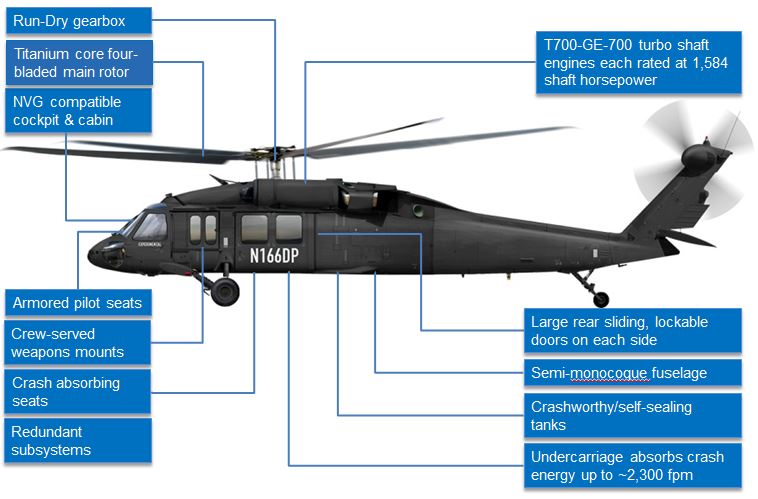Browsing Success: UH 60 Helicopter Maintenance Finest Practices
Browsing Success: UH 60 Helicopter Maintenance Finest Practices
Blog Article
Understanding the Mechanics and Engineering Behind Uh 60 Helicopters
The UH-60 helicopter, typically known as the Black Hawk, stands as a peak of modern rotorcraft modern technology, symbolizing a mix of durable engineering and elaborate technicians. As we peel back the layers of the UH-60's layout, a globe of complex systems and thorough engineering comes to light.
History of UH-60 Helicopters
The history of UH-60 helicopters traces back to the late 1970s when the United States Army sought a sophisticated and functional energy helicopter to replace its aging fleet. In reaction to this need, the Sikorsky Aircraft Company developed the UH-60 Black Hawk helicopter. Introduced in 1979, the UH-60 swiftly came to be a staple in army procedures because of its outstanding capacities.
The UH-60 was designed to excel in a variety of missions, including troop transportation, clinical discharge, electronic warfare, and special operations. Its capability to adjust to various duties made it a useful asset to the U.S. uh 60. Army and various other army forces worldwide
Over the years, the UH-60 system has actually gone through numerous upgrades and variations to enhance its efficiency and maintain rate with advancing goal demands. These helicopters have seen considerable service in disputes such as the Gulf War, Afghanistan, and Iraq, showcasing their reliability and versatility in diverse functional environments. The UH-60's abundant history is a testimony to its enduring legacy as a leading energy helicopter.

Engine and Power Equipments
Using advanced propulsion technology, UH-60 helicopters are geared up with sophisticated engine and power systems to guarantee optimum efficiency and reliability in a variety of operational circumstances. The UH-60, typically referred to as the Black Hawk, is powered by two General Electric T700-GE-701D engines, each capable of providing up to 1,940 shaft horse power. These turboshaft engines offer the necessary drive for the helicopter to accomplish its goals effectively, including army transport, medical evacuation, and fight support.

Rotor System and The Rules Of Aerodynamics
Exactly how do the rotor system and the rules of aerodynamics of UH-60 helicopters contribute to their operational performance and flight capacities? The blades system of the UH-60 helicopter plays an important function in providing lift and propulsion. The UH-60 features a four-bladed, completely expressed blades system that permits high maneuverability and security throughout flight. This design makes it possible for the helicopter to carry out a variety of objectives, from transportation and clinical discharge to deal with procedures.
Aerodynamics likewise play a vital role in the performance of UH-60 helicopters. The streamlined fuselage and rotor blade style lower drag, enabling the helicopter to accomplish higher speeds and better fuel efficiency. The aerodynamic style of the UH-60 likewise adds to its ability to run in varied ecological problems, including warm temperature levels and high altitudes.
Avionics and Flight Control Solution

In its complex coordination with the blades system and aerodynamics of UH-60 helicopters, the avionics and flight control systems create a crucial network of technologies shaping the aircraft's operational abilities. In the UH-60, these systems More about the author include digital display screens, communication radios, General practitioner navigating, climate radar, and auto-pilot systems.
The trip control systems of the UH-60 are in charge of converting the pilot's inputs right into the appropriate adjustments to the rotor system, guaranteeing steady flight and maneuverability. These systems are composed of hydraulic actuators, servos, and computers that function together to regulate the tail and primary rotors, along with other flight control surface areas. By exactly handling the helicopter's trip dynamics, these systems allow pilots to carry out my latest blog post a wide variety of objectives, from transportation and search-and-rescue to deal with operations, with accuracy and confidence.
Duty and Applications in Aviation
Avionics systems in UH-60 helicopters include an array of electronic systems that aid in navigation, interaction, monitoring, and controlling different aircraft features. These systems include digital display screens, auto-pilot systems, interaction radios, GPS navigation equipment, and weather radar. Furthermore, these systems integrate security attributes such as auto-pilot modes, terrain recognition cautioning systems, and security enhancement systems to improve the general safety and operational capacities of the UH-60 helicopters in different missions, including army transport, clinical discharge, search and rescue, and aerial firefighting.
Conclusion
To conclude, the UH-60 helicopter is a flexible airplane with an abundant history and progressed design. Its engine and power systems, blades system, the rules of aerodynamics, avionics, and flight control systems all collaborate to make it a effective and reputable machine. The UH-60's role and applications in air travel are huge, varying from army operations to look and rescue objectives. Its proceeded growth and usage demonstrate its relevance in the area of aviation (uh 60).
In its intricate control with the rotor system and the rules of aerodynamics of UH-60 helicopters, the avionics and trip control systems form an important network of technologies forming the airplane's operational capabilities.The flight control systems of the UH-60 are responsible for equating the pilot's inputs right into the proper changes to the rotor system, ensuring stable flight check my source and ability to move. Avionics systems in UH-60 helicopters encompass an array of electronic systems that help in navigating, interaction, monitoring, and controlling different airplane features. Additionally, these systems integrate safety attributes such as autopilot settings, surface awareness advising systems, and security enhancement systems to improve the general safety and security and operational capabilities of the UH-60 helicopters in different goals, including army transport, medical discharge, search and rescue, and airborne firefighting.
Its engine and power systems, blades system, aerodynamics, avionics, and trip control systems all work together to make it a reliable and reliable maker.
Report this page